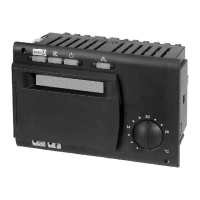118/218
Siemens Building Technologies Basic Documentation RVA63.242, RVA53.242 CE1P2373E
Landis & Staefa Division Description of heating engineer settings 26.03.2001
4.54 Type of d.h.w. demand
Use of different d.h.w. heating modes.
Use of d.h.w. storage tanks with control thermostats.
Defines the type of d.h.w. control (via d.h.w. sensor or control thermostat).
Setting of this function has an impact on the automatic generation of the type of plant
(also refer to “plant types” in index.
Setting range Unit Factory setting
0 / 1 Increment 0
By making this setting, the controller takes into account the signal fed to it by the d.h.w.
sensor conected to terminal B3.
Entry:
0 Sensor: The temperature measured with the sensor is used for the control of the
d.h.w. temperature
1 Control thermostat: The switching status of the control thermostat connected to
terminal B3 is used for the control of the d.h.w. temperature
The contacts of the control thermostat must be suited for extra low voltage (gold-
plated)!
• When using a d.h.w. temperature sensor:
The controller calculates the switching points with the respective switching
differential as a function of the d.h.w. temperature setpoint entered.
Sensor / line with a short-circuit = Fault status signal
Measuring signal present = d.h.w. according to setpoint
Sensor / line with a short-circuit = no d.h.w.
• When using a d.h.w. control thermostat:
The controller takes into consideration the switching statuses of the control
thermostat.
Contact closed = d.h.w. heating ON
Contact open = d.h.w. heating OFF
Contact resistance too high = fault status signal from thermostat
When using a d.h.w. control thermostat, reduced operation is not possible. D.h., wenn
gemäss Brauchwasserprogramm (Zeile 121) Reduziertbetrieb aktiv ist, dann ist die
BW-Bereitung mit Thermostat gesperrt.
• The nominal d.h.w. temperature setpoint must be equal to or higher than the setpoint
adjusted on the control thermostat (thermostat is calibrated at the switch-off point).
• The boost of the flow temperature setpoint of d.h.w. must be a minimum of 10 °C
(has an impact on the charging time).
• In that case, frost protection for d.h.w. is not ensured
Benefits
Description
Note
Setting
Effect
Important
Difference
Note
Important when using a
d.h.w. control thermostat

